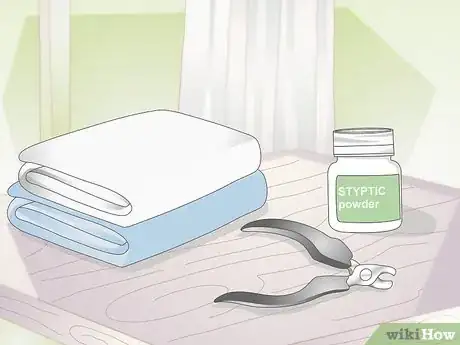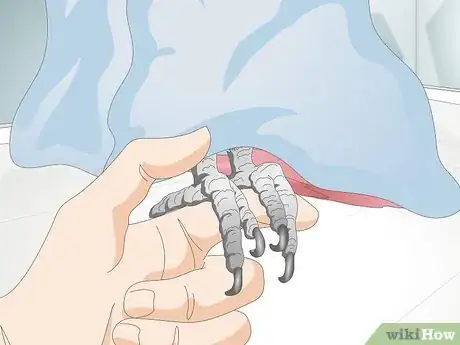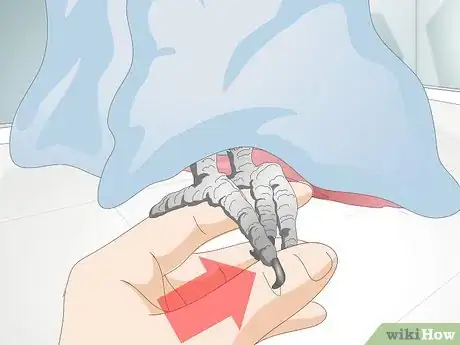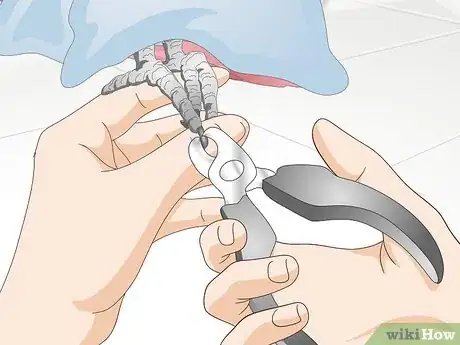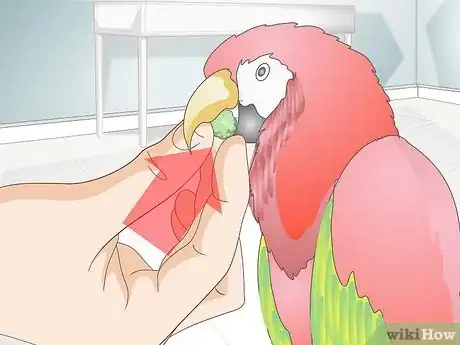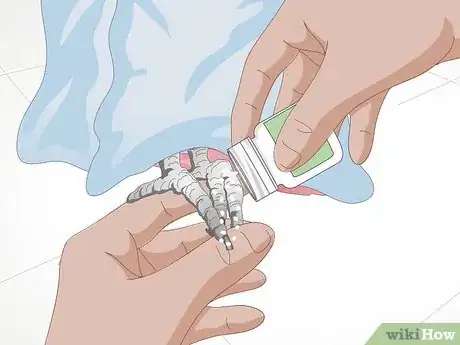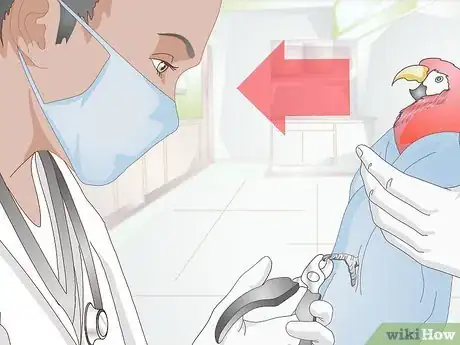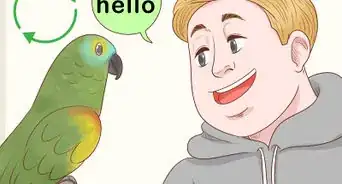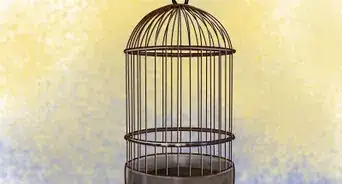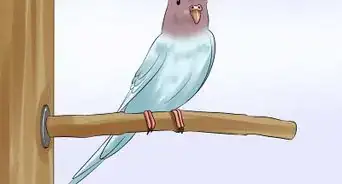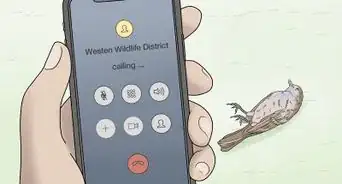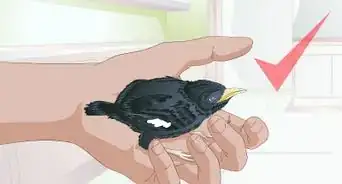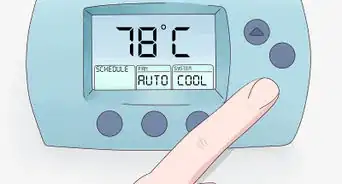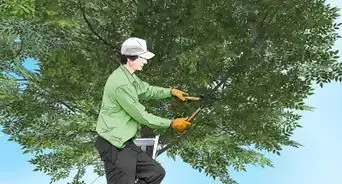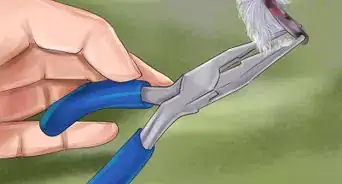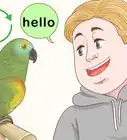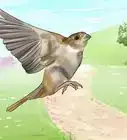This article was co-authored by Pippa Elliott, MRCVS. Dr. Elliott, BVMS, MRCVS is a veterinarian with over 30 years of experience in veterinary surgery and companion animal practice. She graduated from the University of Glasgow in 1987 with a degree in veterinary medicine and surgery. She has worked at the same animal clinic in her hometown for over 20 years.
wikiHow marks an article as reader-approved once it receives enough positive feedback. In this case, 89% of readers who voted found the article helpful, earning it our reader-approved status.
This article has been viewed 153,740 times.
Trimming a parrot's talons can be very difficult. Parrots may resist having their nails trimmed, so only attempt to trim your bird's nails if you've bonded with your parrot. You will have to keep your parrot calm throughout the clipping process. Only trim a small portion of the nail to avoid cutting into the quick and causing bleeding. If your parrot does end up bleeding, use blood stopping powder to stop the flow of blood. Then, get your bird to a vet as soon as possible.
Steps
Beginning the Trimming Process
-
1Make sure your parrot has bonded with you. You should know your bird's body language before attempting to trim its claws. If your bird does not feel comfortable with you, you should wait until you've bonded with it a bit before trimming its claws. The experience will be more traumatic if your bird doesn't trust you.[1]
- If your bird sings, talks, or whistles in your presence, this is a sign it is comfortable with you.
- If your bird flaps its wings in your presence, this is also a good sign. Your bird is attempting to get your attention and is happy to see you.
- Your parrot may also wag its tail, much like a dog, to convey happiness.
-
2Gather all your materials ahead of time. Your bird may squirm or show signs of distress during the clipping process. Therefore, have your materials ready to go before you begin clipping your bird's nails. You do not want to have to be scrambling for anything while you work.[2]
- You will need a pair of nail clippers. You can usually use nail clippers made for people as long as the blade is strong enough. If your parrot has particularly tough nails, try toenail clippers.
- You will need some kind of blood stopping powder in the event your bird starts bleeding. You can find this at a pet store. Make sure the powder is safe to use on birds.
- You will need a towel. Make sure it's a plain color, like white, as birds may be frightened of colorful towels.
Advertisement -
3Get your bird used to the towel. Do not immediately wrap your bird in the towel. This will cause too much anxiety. Instead, allow your bird to get accustomed to the towel on its own.[3]
- Lay the towel down on your hand. Coax the bird to crawl on the towel. Call it softly and say things like, "Good bird" as it approaches the towel.
- Let the bird stand on the towel for a few minutes. You want it to be comfortable with the towel before proceeding.
-
4Wrap the bird in the towel. You need to do this carefully to avoid injuring the bird. You do not want to put pressure on the bird's chest as you wrap it in the towel.[4]
- Drape the towel over the bird's back. Leave its head uncovered.
- Hold the bird at its sides without touching its chest. Wrap the towel around the bird's body.
- Hold the bird's head with your other hand. This will prevent it from biting. Place your thumb on one side of the head, and your index finger on the other. Hold the bird firmly enough that it cannot turn its head.
- Have a friend help, if necessary. You may not be able to trim your bird's nails on your own. Your friend can wrap the bird in the towel while you trim its nails.[5]
Trimming Your Bird's Nails
-
1Allow your bird to grasp onto your finger. Your bird's feet should be exposed at the bottom of the towel. Place your finger near your bird's feet. Allow it to grasp onto your finger on its own. This may take a few minutes, so be patient. If the bird grasps onto your finger on its own, this reduces the stress of the clipping process.[6]
-
2Lift each nail with your thumb. You want to clip the nails one by one. Once the bird has grasped onto your finger, use your thumb to lift each individual nail. Hold the nail in place with your thumb as you clip.[7]
-
3Identify the quick. This is vital to your bird's safety. The quick is the nerve ending in the nail. If you cut into the quick, your bird will bleed. It is possible for a bird to die if it bleeds during the clipping process.[8]
- If your bird has clear or light colored nails, the quick should be easy to find. The quick is pink, and you should be able to see it in the nails.
- With dark colored nails, this can be trickier. Just trim a small amount of the nail at a time. With darker nails, you should only ever trim off the tips of the nails as the risk of accidentally cutting into the quick is higher.
-
4Trim your bird's nails. Simply use the nail trimmer to cut off the tips of the bird's nails. Trim off a small amount of nail at time, keeping a good distance from the quick. You should only trim a small amount of your bird's nails to avoid hitting the quick. Trimming the tips is usually sufficient.[9]
- You should also give the bird verbal praise for behaving during the clipping process.
-
5Give your parrot treats after clipping its nails. You want your parrot to associate nail trimming with happy, positive things. This will make it more likely to behave next time. When you're done clipping your bird's nails, offer treats as a reward.[10]
Avoiding Accidents
-
1
-
2Stop if your bird becomes extremely distressed. Birds can actually have physical reactions to stress. If you notice your bird is struggling to breathe, stop attempting to clip its nails. You will have to try another time.[13]
- If your bird is panting, or if its eyes are rolling back into its head, stop. Put your bird back in its cage until it calms down. Speak in a soothing tone to encourage your bird to relax.
- You should also stop trimming if your bird is squirming too much. If a bird will not keep still, this increases the risk of injury.
-
3Have a veterinarian trim your parrot's nails if you cannot do it. You may not feel comfortable clipping your parrot's nails. If this is the case, take your bird to a vet. It's better to spend the extra money having professional help than risk injuring your bird.[14]
Warnings
- Bleeding should not be taken lightly. Parrots can actually bleed to death if you cut into the quick. If your parrot starts bleeding, stop the blood with blood stopping powder and immediately take it to the vet.⧼thumbs_response⧽
References
- ↑ http://www.peteducation.com/article.cfm?c=15+1795&aid=3334
- ↑ http://www.petmd.com/bird/grooming/evr_bd_trimming_nails#
- ↑ http://www.petmd.com/bird/grooming/evr_bd_trimming_nails#
- ↑ http://www.petmd.com/bird/grooming/evr_bd_trimming_nails#
- ↑ http://www.petuniversity.com/birds/parrots-and-parakeets/grooming-parrots.htm
- ↑ http://www.petmd.com/bird/grooming/evr_bd_trimming_nails?page=2
- ↑ http://www.petmd.com/bird/grooming/evr_bd_trimming_nails?page=2
- ↑ http://www.petmd.com/bird/grooming/evr_bd_trimming_nails?page=2
- ↑ http://www.petmd.com/bird/grooming/evr_bd_trimming_nails?page=2
- ↑ http://www.petmd.com/bird/grooming/evr_bd_trimming_nails?page=2
- ↑ https://www.beautyofbirds.com/nailclipping.html
- ↑ http://www.petmd.com/bird/grooming/evr_bd_trimming_nails?page=2
- ↑ http://www.petmd.com/bird/grooming/evr_bd_trimming_nails?page=2
- ↑ http://www.petuniversity.com/birds/parrots-and-parakeets/grooming-parrots.htm
About This Article
To trim parrot claws, wrap the bird's body up gently in a towel, taking care to leave its head and feet uncovered. Next, place your finger near your bird's feet and let it to grasp onto your finger. Then, use your thumb to lift each individual nail, hold it in place, and use a nail trimmer to cut off the tips. Be sure to trim off a small amount of nail at time and keep your distance from the quick! Finally, praise your parrot verbally and give it a treat. For more tips on avoiding accidents and injuries, read on!

